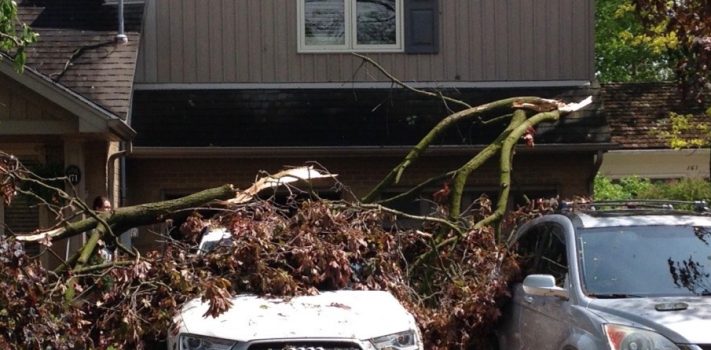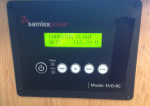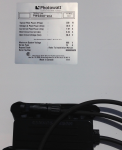(Continued from Part 2. This concludes the article.)
Inverters
Most of us are interested in running a few 120 volt AC appliances. The fridge, the furnace, the shallow well pump – standard AC devices that we want to keep alive during a power outage. For these we will require what is known as an inverter. Inverters take DC battery power and invert it into standard 120 volt AC household power.
Inverters are available in all shapes and sizes these days. You can get off-shore-manufactured modified sine wave inverters that plug into the cigarette lighter plug in your car, rather cheaply. These might even be enough to charge your phone, or laptop computer. The rule of thumb is that these devices produce about half of what they consume. For example, if your cigarette lighter plug is fused at 15 amps at 12 volts DC, the inverter can be expected to produce a little less than 1 amp at 120 volts AC.
If you want to run other appliances, you will need a far more robust inverter. Cheap Chinese-made inverters rated at 2000 watts can be had these days for under $1,000 – sometimes far less than that. These might mostly work at the stated spec, but read the fine print before you decide to buy. And keep in mind that they are often rated for momentary maximum draw, not continuous draw. That 2000 watts stated capability might realistically be less than 1500 watts, continuous. Momentary draw duration also tends to vary, by manufacturer. For some manufacturers, momentary might refer to 15 seconds. To others momentary might be based on 15 minutes. You do tend to get what you pay for.
Figure 3: Higher-end inverters incorporate chargers for grid, generator and solar charger.
Moreover, if you intend to run appliances with electric motors, or other reactive devices, you might want to research load factors. For example, a motor that might draw 9 amps (1100 watts) continuously once running, might require 20 amps (2400 watts) to even get started. How quickly will it make the transition? Some of the better inverters can sustain such overages for a quarter-hour. Other cheaper units might fail in terms of seconds.
Also, keep in mind that the cheap inverters produce what is known as a modified sine wave. The power grid on the other hand supplies a true sine wave. Not all appliances will work acceptably given a modified sine wave. The better inverters always produce proper sine waves – but that is just the start. The higher-end inverters will automatically go into a heavy power-saving mode when they detect no 120 volt draw and will seamlessly come back on the microsecond you plug something in. The best inverters are also very heavy.
The other factor to keep in mind with running an inverter, is that you will need very heavy copper to connect the input supply power. Copper is expensive. If you want to run a 120 vac, 2000 watt, at 15 amps continuous, it could draw around 200 amps at 12 volts DC. DC resistance is significant and voltage drop can quickly become a problem – so keep the runs short as possible. We are talking heavy-duty ‘welding wire’ in which copper is a perhaps a half inch in diameter. Depending on your specific situation this might translate into a 00 American Wire Gauge (AWG). Normally these data are provided in the inverter manual, although tables also exist online which can assist you in determining the AWG based on length and your current requirements.
You can reduce your cost of wiring by, instead of 12 volts, configuring your system at a higher voltage. By placing four 6 vdc deep cycle batteries into series, you can work at 24 volts nominal. Most heavy truck appliances will be able to be fused directly to a 24 vdc system. Our DC Danfoss-based freezer can work at 24 volts. Just be aware, that if you go with a 24 volt system, you will additionally need a 24 to 12 vdc converter to power those appliances that require just 12 volts.
If you place batteries in series, in parallel, or in series-parallel, you must consider the fact that each battery must be of the same type, age, and condition. It will not work well in this configuration if batteries are dissimilar.
Very large PV systems which happen to make use battery storage are often wired based on 36 or 48 vdc. If you are thinking to power heavy-duty appliances, you will want to thoroughly research higher battery voltage systems.
Large, often government-subsidized, PV arrays are usually wired using grid-tied inverters that only work when the grid is up. While these are beyond the scope of this article, it would be interesting to read about specific experience in modifying a grid tied array to become useful in the context of a backup power system.
Backup Power Systems Contrasted
A typical non-PV backup power system relies on generator power. The problem with generators are that they rely on fuel that might be in short supply and they can be associated with significant noise signatures. Moreover, except for some very expensive installations, they are not typically on standby when the power goes out. Most people have to haul them out of storage, only to find that they can’t find the extension cords. Then they get to deal with the fact that they have not been test-started in quite some time and the fact remains that gasoline does go bad after a while. By the time you have dealt with all the gremlins your water pipes have frozen, or in a warmer climate, your freezers will have all long thawed.
The solar backup power system, on the other hand, is always on standby and when the power fails it automatically fails over within a fraction of one cycle of a sine wave. Brownouts and power problems experienced by the grid are thus not experienced by your appliances.
The only time you would need to fire up a generator is if you have too small a battery pack, too heavy a load, or you get an extended period without direct sunlight. In any case, it buys you a significant amount of time until you get the generator set up and running. With a sophisticated inverter-charger, you can configure it to automatically start your generator when the batteries are low and to shut the generator down once the batteries are adequately charged or the sun returns – thus, conserving precious fuel.
The way that our PV backup system is wired does not require a special transfer switch. The inverter-charger is plugged into a standard 120 vac circuit and whatever appliances you want to keep running are simply left plugged into the inverter at all times. With this system it automatically switches from grid to battery when required. If the grid power comes up in the meantime, it will switch back while it recharges the batteries. I also ran a special backed-up power circuit in the house for those critical appliances that I want to keep alive during an outage.
Our Backup Power System Details
Fail early, fail often – fail while the cost of failure is still relatively low. This is the fifth system I have set up – only the first one I considered a total failure, but I didn’t quit there. The fifth, incorporates many things I have learned over the past 25 years.
Figure 4: Specifications were provided on the back of these PV panels.
The following is a fairly detailed description of the backup power system that we have set up at an in town location. I do describe everything I do as an experiment and it can be discussed as a basis for improvements. Having said that, this is a system that works fairly well for the objectives I had set out.
It begins with four Photowatt 230 watt photovoltaic (PV) panels providing a theoretical maximum of 920 watts of power. These are connected in two strings, each which consists of a pair of panels in series, this, because the open circuit voltage (Pov) of these panels is 36 volts and the charge controller maximum Pov is 120 volts. Pov is listed in the specifications for our charge controller and is marked on the back of the PV panels. If I had placed all four panels into a single string they would have exceeded the rating of the charge controller.
Figure 5: Four Photowatt 230 watt photovoltaic (PV) panels.
I had previously used aluminum structures to mount the panels. This particular installation occurred during the lockdown days of the ‘scamdemic’ and the only materials available in these parts were some very bad cedar boards. So I experimented, building a pure wood structure instead of aluminum. In retrospect, I might not have mounted ham radio vertical antennas to the south of the panels.
When mounting panels in northern latitudes, mount them so that you can tilt them near vertical for the November through February months, both to shed snow load and to be incident to the lower angle of the sun in winter.
Figure 6: When estimating solar energy production in northern latitudes, don’t neglect to factor in the limitations of your environment.
The panels are equipped with industry-standard MC4 plugs, male and female. They are wired to the charge controller using ultraviolet (UV) resistant #10 AWG feed lines.
A Morningstar ProStar 40 Amp MPPT charge controller connects the PV panels through the inverter-charger to the batteries. The panels will only produce a theoretical 30 amps maximum.
The Samlex pure sine wave EVO 2224 inverter-charger simultaneously marshals power from the PV charge controller, from a generator, and from the grid. It can be configured to automatically start the generator as needed.
The four Crown 235 amp hour (AH) deep cycle six volt batteries in series make 24 vdc. The batteries are wired to the inverter using five feet of 0/2 (double ought) copper ‘welding’ wires to which I used a hydraulic crimper to attach copper lugs equipped for 5/16” terminal studs. The wires which bring the CR-235’s into series are 18” lengths of #1 AWG.
The shunt-based battery monitor system is a Bogart Engineering Trimetric TM-2030. The TM-2030 was ordered with optional WF-2030 WiFi module. The main reason I ordered the WiFi module is because I was hoping it would provide easy access to data.
The WiFi allows one to configure the TM-2030 using a web page rather than the control panel. It also allows you to easily display voltage, amps and history on web pages rather than on the LED display. Oddly, however, there seemed no simple way to save data to a local CSV file via this WiFi module.
We have one Unique DC powered 9 cu ft freezer. These DC appliances make use of the Danfoss compressor which runs efficiently fused directly off of the 24 volt batteries. These appliances can alternatively run off of 12 vdc.
The Samlex EVO inverter powers the cistern water pump, the water level monitoring system, as well as the natural gas-fueled furnace. It can also power our relatively inefficient conventional refrigerator and whatever else we decide we require to plug in. Of course, plugging more appliances into the inverter works best if you have greater battery capacity than I was initially planning for. I had figured that for a long-term power outage, only the one deep freezer would need to be kept alive.
The refrigerator would be nice to have. Our longer-term goal is to switch out our standard Westinghouse fridge for a DC-powered unit. DC-based appliances are more expensive (with fewer ‘luxury’ features) than standard mass market equivalents.
The inverter-charger has a 20 amp input connection to grid power, and another that can simultaneously be connected to a generator. The EVO could be configured to automatically start and stop the generator as mentioned previously.
The documentation for the EVO-2224 suggests that the unit is capable and could be wired with greater than a 12 AWG (20 amp) AC, however, I already chose the 20 amp Square D breakers. Any AC appliance plugged in through the inverter will receive conditioned power from the grid until grid goes down, at which point it will seamlessly supply inverted power from battery storage in a fraction of a second.
A down converter, 24 vdc to 12 volt at 20 amps, is switched to provide power to my 12 vdc appliances. The DC pony pump that I use to transfer water between my IBC totes and my cistern is such a 12 vdc appliance. I pump the water from the collection tote through a 30 micron filter so as to reduce the problem of algae in the stored water.
With the exception of the heavy current wires, all the remaining DC circuits used Anderson Power Poles (APP) with Blue Sea fuse panels using automotive style ATC blade fuses. We standardized on the use of the orange-black APP convention for the 24 volt and red-black for 12 vdc.
Conclusion
At some point in our lives we should anticipate experiencing the end of the world as we know it. How versatile will we be in such a world? Part of the preparation process for such involves acquiring knowledge and skills while the cost of such is still low. In part, it can involve anticipating what resources will be required and what resources might become commonly available in such a future scenario.
In this essay, I have attempted to provide a primer for commonly available components that can be combined to produce a backup power system for when the grid power becomes unreliable, horribly expensive, or completely unavailable. The modular system described can be extended to more traditional backup power systems involving gasoline, diesel, propane, or, natural gas generators. It is best not to depend too heavily on these fuel-driven means, because in a grid-down scenario the refineries and distribution systems would be affected.
The amount of energy produced by a typical portable generator can easily be enough to run your 240-volt washer and dryer for a short time, whereas solar systems required for such heavy loads represent a higher level of investment. If you have plenty of roof space, it is possible even to run a small mini-split heat pump for air conditioning – however, the cost is bound to become significant and you might want to settle for just an inexpensive fan and a commonly available dehumidifier run off an inverter as described.
I am an experimenter – I do not do advertising or sales, in case that is not already obvious. I documented what I learned and what I have done, whether or not it is the best way I leave it with you. Makes and models of equipment I use have been included with sufficient detail to get started with your own research. At the moment specifications for each are readily available on the internet for you to download and save to your EMP-resistant flash drives. In the near future I hope to read about a plethora of other first-hand experiences.
Also, you would do well to familiarize yourself with the tips provided in June 2024 by Tunnel Rabbit, “Extending The Life of Flooded Lead Acid Batteries” – especially if you are trying to revive an abused battery in a pinch.
Experimenting is not an afterthought – it permeates everything I do – the recognition that the invisible, the living, the one who is, and who was, and who is to come – the one who is generous and gracious, it is He who inspires creativity and our continued well-being – above all, go with Him.













